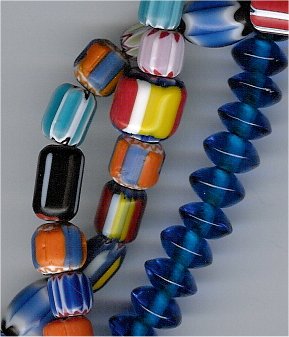Bead
Beads are small, decorative objects that are formed in a variety of shapes and sizes, and are made from many different materials including glass, plastic, metal, wood, stone, and bone. They have been used for thousands of years in many cultures around the world for personal adornment, as currency, in jewelry making, and in art and decoration. Beads can be strung on thread, wire, or cord to create necklaces, bracelets, earrings, and other decorative items. The practice of using beads in crafts and fashion is known as beadwork.
History[edit | edit source]
The history of beads dates back to at least 100,000 years ago, making them one of the oldest forms of personal adornment. The earliest beads were made from natural materials like bone, shell, and stone, and were often used in burial ceremonies, suggesting they held significant cultural and spiritual value. In ancient Egypt, beads were made from gold, silver, and semi-precious stones and were a symbol of wealth and status. The Indus Valley Civilization (c. 3300–1300 BCE) was known for its advanced bead-making techniques, including the use of agate, carnelian, and lapis lazuli. Beads were also important in the cultures of ancient Mesopotamia, China, and Mesoamerica, where they were used in trade and as symbols of power and prestige.
Materials and Manufacturing[edit | edit source]
Beads are made from a wide range of materials. The choice of material depends on the desired appearance, durability, and cost.
Natural Materials[edit | edit source]
- Bone and Ivory: Often carved into intricate shapes, these materials have been used since prehistoric times.
- Wood: Lightweight and versatile, wood beads can be painted or varnished.
- Stone: Includes precious and semi-precious stones. They are often polished to highlight their natural beauty.
- Shell: Used to create beads with natural patterns and textures.
Synthetic Materials[edit | edit source]
- Glass: Glass beads can range from simple, solid-color designs to complex, multicolored patterns known as millefiori.
- Plastic: Offers a wide range of colors and shapes at a low cost. It's used in both children's crafts and high-fashion jewelry.
- Metal: Metal beads add weight and a luxurious feel to jewelry. They can be made from gold, silver, copper, and other metals.
Manufacturing Techniques[edit | edit source]
- Handmade: Many beads are still made by hand, using techniques that have been passed down through generations.
- Molded: Beads can be molded from glass, plastic, or metal in mass-production processes.
- Carved: Stone, bone, and wood beads are often carved and polished to reveal their natural beauty.
Uses[edit | edit source]
Beads have a wide range of uses beyond personal adornment. They are used in interior design, in the creation of artworks, and in educational activities to help with counting and pattern recognition. Beads also play a role in various cultural practices and ceremonies, including prayer beads in religious contexts like the Rosary in Christianity or the Mala in Buddhism and Hinduism.
Cultural Significance[edit | edit source]
The cultural significance of beads is vast and varied. In many cultures, beads are more than just decorative items; they are imbued with meaning. They can signify status, achievements, identity, and beliefs. For example, in some African cultures, beads are used in ceremonies related to birth, coming of age, marriage, and death. In Native American cultures, beadwork patterns and colors can convey specific meanings and stories.
Search WikiMD
Ad.Tired of being Overweight? Try W8MD's NYC physician weight loss.
Semaglutide (Ozempic / Wegovy and Tirzepatide (Mounjaro / Zepbound) available. Call 718 946 5500.
Advertise on WikiMD
|
WikiMD's Wellness Encyclopedia |
| Let Food Be Thy Medicine Medicine Thy Food - Hippocrates |
Translate this page: - East Asian
中文,
日本,
한국어,
South Asian
हिन्दी,
தமிழ்,
తెలుగు,
Urdu,
ಕನ್ನಡ,
Southeast Asian
Indonesian,
Vietnamese,
Thai,
မြန်မာဘာသာ,
বাংলা
European
español,
Deutsch,
français,
Greek,
português do Brasil,
polski,
română,
русский,
Nederlands,
norsk,
svenska,
suomi,
Italian
Middle Eastern & African
عربى,
Turkish,
Persian,
Hebrew,
Afrikaans,
isiZulu,
Kiswahili,
Other
Bulgarian,
Hungarian,
Czech,
Swedish,
മലയാളം,
मराठी,
ਪੰਜਾਬੀ,
ગુજરાતી,
Portuguese,
Ukrainian
Medical Disclaimer: WikiMD is not a substitute for professional medical advice. The information on WikiMD is provided as an information resource only, may be incorrect, outdated or misleading, and is not to be used or relied on for any diagnostic or treatment purposes. Please consult your health care provider before making any healthcare decisions or for guidance about a specific medical condition. WikiMD expressly disclaims responsibility, and shall have no liability, for any damages, loss, injury, or liability whatsoever suffered as a result of your reliance on the information contained in this site. By visiting this site you agree to the foregoing terms and conditions, which may from time to time be changed or supplemented by WikiMD. If you do not agree to the foregoing terms and conditions, you should not enter or use this site. See full disclaimer.
Credits:Most images are courtesy of Wikimedia commons, and templates, categories Wikipedia, licensed under CC BY SA or similar.
Contributors: Prab R. Tumpati, MD





